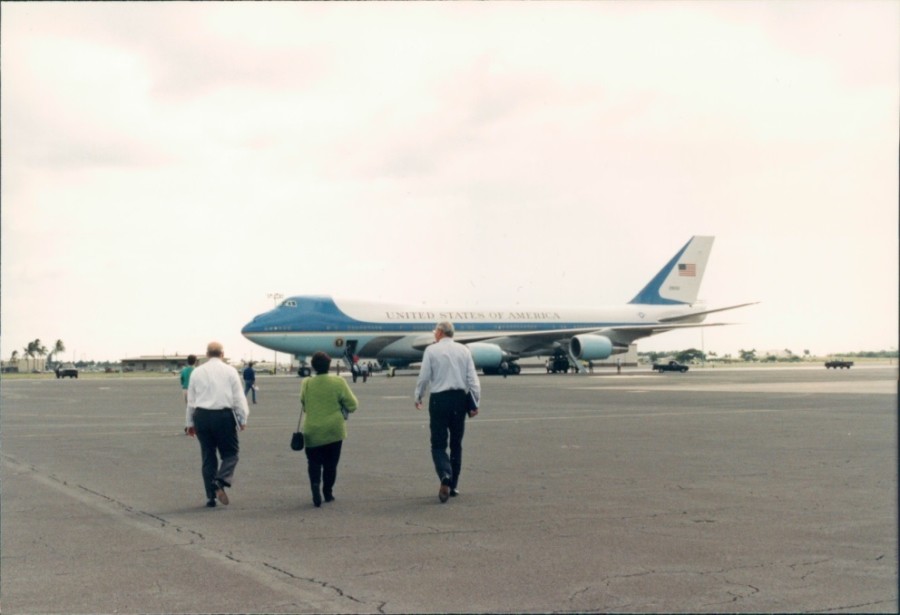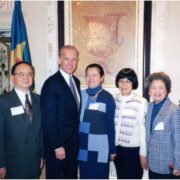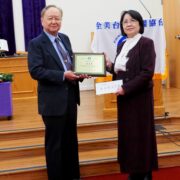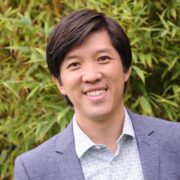An Immigrant’s Experience on Air Force One – The Story of Winston Chen
By Nicole A. Chen
Introduction
This is a true story of an Asian immigrant who had close to nothing in his pockets when he migrated to the United States to attend school a few decades ago. A story like this one would almost never happen in a foreign country. However, living in America gave this man so many opportunities to choose from, this being one of them. His incredible story led him through a wondrous dream-like journey where he eventually ended up on Air Force One with a much- honored man: President George Herbert Walker Bush.
This is also a story about a time in history when the Japanese emerged as the better producer of automobiles, causing Americans to doubt their economic future. At one point, Japan appeared ready to take over the world economy. A prominent yet horrifying scene during President Bush’s Asian-Pacific trip when he vomited on the Japanese Prime Minister’s lapel and collapsed at the state dinner in Tokyo in 1992 symbolized the American fragility and apprehensiveness that existed during this time.
This is a story of miracles too. While the Americans experience defeat, some searched their souls to ponder what was lying ahead. Many wondered if the heydays of the economy were really over. Unexpectedly, American resilience and creativity reversed the roles between them and the Japanese through the next few decades.
This is a truly incredible underdog story of an immigrant trying to live his American dream, intertwined with the fascinating comeback of the almost-failed American economy.
“Miracles happen every day. Not just in remote country villages or at holy sites halfway across the globe, but here, in our own lives.” -Deepak Chopra
Biography – From an Immigrant to CEO
Living in a middle-class family in Taipei, Taiwan with his parents, a sister, and two brothers, Chen only had so much he was responsible for. Being a little kid with loving parents, oyster pancakes, and his beloved pool table was all he needed to think about. His father owned and managed a construction firm, and instilled a strong work ethic upon his children. Because of this, Chen was a hard-working student, and graduated first in a class of 130 students in college. In 1964, he graduated from National Cheng Kung University in Taiwan with a B.S. in Civil Engineering. Then, he went to the Air Force for a year to fulfill mandatory service. Since Chen rarely traveled, most of the world was unknown to him. He would have never imagined the life he would soon have to adjust to.
At the age of twenty-four, through excessive determination, Chen landed himself a graduate scholarship to Harvard University, Cambridge, MA to study Applied Mechanics and Applied Mathematics. He was offered a graduate fellowship of $3,500 a year to study in the area of advanced mechanical properties of materials (solid mechanics) related to aerospace structures. Since Chen’s family was not ridiculously rich, he stepped foot onto the Land of Opportunity with only 500 USD. He was filled with excitement and anxiety as he made this huge step toward his dream. He experienced massive cultural shock when he first arrived, as he spoke little English.
Understanding the lectures in the classroom was a big challenge. Only through extra efforts, and by focusing on his dream, did he overcome the numerous hurdles to finish the rigorous process of obtaining a doctorate degree. He got his Master’s degree in 1967, and his Ph.D. in 1970. His doctorate thesis was entitled, “Necking in a Bar” (a metal bar). The study was the first computerized analysis of the large deformation of a metal bar under tensile force, a standard test that has been used for hundreds of years. His Ph.D. advisor was the internationally-renowned Professor Bernard Budiansky.
These four-and-a-half years were one of the best times in his life. Chen knew that Harvard’s generosity of granting fellowships without expecting anything in return could only happen in America, and for that he was very grateful. At the time of his graduation in 1970, he wondered many times why this generosity was bestowed on him. This strong feeling of being blessed prompted him later in life to set up a charitable foundation and raised millions of dollars to donate to Harvard and other universities for the purpose of setting up scholarships to help others.
After graduating from Harvard University, he secured his first job working for International Business Machines Corporation (IBM) as a staff engineer to develop new computer printing technology in Endicott, New York. He and a senior engineer pioneered the high-speed inkjet printing technology for three years before he was transferred to San Jose, CA. in 1973, the center of the innovative Silicon Valley. In 1974, he was promoted to be a manager, and later was transferred to a magnetic-recording group to develop thin-film head technology for computer tape drives. While living in the Silicon Valley area, he sensed the tremor of the personal- computer revolution coming.
Soon after, Chen decided to branch out from IBM to start his own company.
The Start of Solectron
Shoestring to Multi-billion Dollar Company
With a savings of only $100,000, after working for IBM for 8 years, Chen’s options to start a company were limited. In 1978, after reviewing various small companies, he and Roy Kusumoto acquired Solectron in a fifty-fifty partnership. Solectron had been started in 1977 with $150,000 investment by two Indian-Americans and Kusumoto to repair Atari home-video game consoles. In one year, the company did $400,000 sales and lost $150,000. When Chen came along, the company was basically insolvent. It owed the IRS $60,000 employee-deducted taxes, and owed $90,000 to suppliers. Chen agreed to repay the initial investment of $150,000 to the two Indian-American investors in one year in exchange for ownership.
When Chen put down $100,000 in September 1978, that money disappeared in two days to pay off the IRS and to pay off some suppliers. The business condition was bleak. The company was doing $30,000 in sales a month, and losing $30,000 a month. Chen did not have any other savings. He had no choice but to fight for suvival. Many of his friends thought that he was out of his mind, giving up a nice, secure managerial job at IBM to jump into a company that could go broke any time. For Chen, though, it was not the time to wonder, but to learn to swim as fast as possible as if alligators were biting his butt.
Luckily, it was the beginning of the PC revolution, and business was booming. At the time, quality was a big problem at Solectron, and the costs of rework were devastating. Of Selectron’s thirty employees, ten spend time doing rework. Cash-flow was zero, and suppliers constantly threatened to cut off. The result was continuous chaos, constant rumors of bankruptcy and low employee morale.
During his eight years at IBM, Chen was engaged in advanced R&D technology work, not in manufacturing. Manufacturing was foreign to him. He had to roll up his sleeves and learn Manufacturing 101. Luckily, his Ph.D. research training enabled him to learn this new field quickly. He mortgaged his house to buy a new soldering machine for the printed circuit boards. The results were immediate. Defects and rework were cut by 90%, and total cost was reduced by 30%. After operations were streamlined, the company broke even in three months.
The following year, sales tripled to $1.2 million. $150,000 was paid back to the original two investors. To finance growth, Chen and Kusumoto had to raise another $200,000 from their friends, Jim Lin, Tim Lim, Clarence Lee and Kay Shimada. When Chen announced a10-year plan to grow the business to $100 million, Clarence Lee laughed out loud, saying he would be happy to see $10 million in ten years.
Contract manufacturers or Electronic Manufacturing Service companies (EMS) for the electronic industry had existed for many years. They built key parts like printed circuits-boards for high-tech companies in computer, telecommunications, computer peripheral, networking, and consumer electronics’ industries. In 1987, there were about 300 mom-and-pop assembly contractors in the Silicon Valley, with the largest one reaching annual sales of up to $3 million. Solectron was the first professionally-managed manufacturing service company that would grow beyond that level.
Solectron stumbled onto the beginning of the huge global-manufacturing outsourcing trend. In five years, Solectron experienced a 125-fold increase in growth to annual sales of $50 million. The number of employees grew from 30 to 2,000. It was not a straight line of growth. Rather, the company went through twists and turns characterized by the ups and downs of Silicon Valley. Because of its rapid growth, the company was strapped for cash. For three years Chen deposited customers’ checks at Hibernia Bank every Friday afternoon in order to meet the employee payroll the following Monday. However, through all of his hard work, Solectron became the largest Electronic Manufacturing Service Company (EMS) in Silicon Valley.
The Electronic Manufacturing Service (EMS) companies offered cost-effective manufacturing and quick ramp-up capabilities for high-tech startups. In addition, the startups did not have to spend precious cash for manufacturing facilities themselves, resulting in a significant improvement in return on assets. Most of the successful high-tech companies loved to outsource their manufacturing to EMS. EMS also offered large corporations a significant cost savings in the range of 50-75%. In addition, the high-tech companies were constantly faced with shrinking product life cycles. Because of their manufacturing expertise, EMS could drastically cut the cycle time. Solectron’s customers included IBM, Xerox, Hewlett, Apple, Sun MicroSystems, Cisco, 3Com, Silicon Graphic, Dell, etc. Solectron assembled and tested printed circuit boards, mainframe disk drives, cables and systems for its customers. Solectron became an important manufacturing partner for high-tech companies who gained an edge in quality, productivity and speed-to-market.
In 1982, Solectron invested in new Surface Mount Technology (SMT) for printed circuit- boards. The Japanese had used SMT for some time to miniaturize circuit boards for consumer- electronic products. SMT required expensive automatic-placement machines made by Japanese precision-machinery companies. Kusumota, a frequent traveler to Japan, believed that the U.S. would soon follow in Japan’s footsteps with the use of SMT. It was clear that SMT would be needed to miniaturize notebook computers and cellular phones in the U.S.
In 1984, Chen helped his friend Dr. Tu Chen start Komag, a company which produced thin-film disks for hard drives. One of the venture capitalists of Komag, Art Spinner of Hambro International asked Chen what he’d done to make Solectron such a success. When Chen told him how, with an investment of $300,000, Solectron grew sales to $50 million, Spinner could not believe it. Usually such a growth required $10-20 million in investment. Spinner proposed to invest $8 million to invest in SMT in exchange for 20% ownership of Solectron. The deal was done in a month. Solectron was ready to march into the big league. In order to assure adequate financing, Solectron needed to go public in the near future.
Solectron’s business was booming, and things could not have been better until they hit a pothole. The Solectron team had worked hard to get a big contract to build IBM’s PC Junior, a high volume and low cost PC. The PC Junior was famous for its advertisement featuring Charlie Chaplin fooling around with the new computer. This was IBM’s belated effort to unseat Apple as the kingpin of the personal-computer business. The contract was a big coup for Solectron that would more than double its business in a year. It proved to be a big risk for Solectron.
When IBM discovered the market acceptance for PC Junior was disappointing, they cancelled the contract. This almost drove Solectron into the ground. IBM fairly compensated Solectron for the costs of semi-processed materials. But the damage was so huge that it was near fatal. Solectron had to lay off hundreds of employees, and ended up with huge, unused facilities. This near-death experience humbled the Solectron management team, as they learned the bitter lesson of excessive risk associated with blind growth.
On the heels of IBM PC Junior project cancellation came the recession of 1985. The overblown enthusiasm for personal computers started to deflate. Even Apple lost money, and Steve Jobs was fired in September of 1985. The economic downturn lagged on for more than two years. Slowly, Solectron recovered from the fiasco, and they were back up on their feet. Kusumoto decided to leave Solectron in 1985 because of a difference of opinion with the Board of Directors. Chen continued to orchestrate the team, always seeking bigger challenges. He recruited his old boss from IBM, Dr. Ko Nishimura, as the Chief Operating Officer (COO) in 1988. Chen also asked Charlie Dickenson, the experienced CEO of a $500-million computer printer company to be Chairman of the Board.
To build a bigger company, Chen focused on two things: building the management team and improving quality. He asked his staff to set up Solectron University to provide managers with 100 hours of management training per year. He decentralized operations and shared the profits with all managers according to their performance. He persuaded the Board to issue the biggest possible percentage of stock options for its managers.
On the quality side, he discovered that the U.S. was gradually losing its manufacturing competitiveness and quality edge to Japan. The biggest example of this was the American auto industry which was being severely beaten up by Japanese car makers. Manufacturing had become a backwater in the U.S. as smart individuals all flocked to work on technology development, and in sales and marketing areas that offered higher pay. Large companies like IBM had excellent quality, but were slow and expensive (with an internal shop rate of $120-150/hour for production). Small companies were nimble and innovative, but lacked good manufacturing expertise.
Chen saw an opportunity to offer world-class quality manufacturing services at a quarter of IBM’s cost. It was Solectron’s vision and mission to help America revive manufacturing quality and productivity. He and his management team studied Dr. Deming’s Statistical Process Control (SPC) that was taught to the Japanese in the 1950’s, Motorola’s 6 Sigma method, Toyota’s Just-in-time, Japanese Taguchi method for Design of Experiment and Loss Function, Philip Crosby’s Zero Defect concept, Japanese Kaizen system, etc. When defects occurred, instead of blaming the workers, he directed his management team’s attention to improve design, process capability and control. The company set up an elaborate computerized quality-control system that could track quality at every stage of a project.
He recruited many Ph.D.s to work on statistical process control, particularly on SMT production. Since SMT required tens of thousands of tiny joints to be soldered precisely, statistical process control became critical. At a time when the industry still used the traditional yield measurement of percentage (%), Solectron had already advanced to measuring defects in Parts Per Million (PPM). Solectron started to be recognized as a leader in quality in the electronic manufacturing business. By 1992, Solectron had received over 400 quality and service awards from its customers.
Business continued to grow for Solectron. In 1989, Solectron sales reached $130 million. The company went public and traded on the New York Stock Exchange. Due to a growing trend in manufacturing outsourcing, and a reputation for superior quality, Solectron’s sales grew to $204 million in 1990, $265 million in 1991 and $406 million in 1992. The stock price soared 579% in three years.
Because of Chen’s help, Solectron became an empowering force that did not go unnoticed by many, including President George H. W. Bush.
The Big News
It was a cool, but clear and sunny morning on Monday, December 15th, 1991. Beth Townsend, a hardworking and well-organized assistant, was in her office completing the tasks at hand. Little did she know the phone call she was about to receive would have her urgently trying to reach her boss to deliver the critical information. A piercing ring from the telephone reverberated through the office and took her out of her focused mindset.
Ten minutes was all that was needed to flip her mood upside down. She went from being calm and collected to desperately needing to call her boss, Winston Chen. The phone call she had received left her wide-eyed. She paged him three times before walking hurriedly off in every direction to locate the man. Roughly an hour later, Beth finally saw Chen when he walked out from an important business meeting with an executive team of a major customer Cisco System to negotiate a new contract for the New Year.
When Chen saw Beth in her flustered state, he immediately picked up on her distress. “What’s the big rush?” he asked.
She replied without mincing words. “President Bush’s office asked you to call back immediately.”
“A call from the White House? You must be kidding. What have I done?”
Chen cautiously wondered what he could have done to elicit a call from the White House. Filled with curiosity, he scurried back to his office to return the call. The secretary for President Bush informed Chen that he and 19 other influential CEOs of America’s major corporations were invited to accompany the president on a 12-day trip to Australia, Singapore, South Korea, and Japan to promote American trade and exports. Chen was also asked to attend a planning session on Thursday, December 19th, 1991 at the White House.
The following executives were invited by President Bush: Dexter F Baker of Air Products and Chemicals, Winston Chen of Solectron Corporation, Beverly F. Dolan of Textron, Inc., Robert Galvin of Motorola, Inc., Joseph T. Gorman of TRW, Inc., Maurice R. Greenberg of American International Group, Bronce Henderson of Detroit Center Tool, James Herr of Herr Foods, Lee Iacocca of Chrysler Corporation, Robert J. Maricich of American of Martinsville, Raymond Marlow, Marlow Industries, John C Marcus of Westinghouse Electric Corporation, Harold A. Poling of Ford Motor Company, Heinz Prechter of ASC Inc., John P Reilly of Tenneco Automotive, James D Robinson III of American Express, David M. Roderick of USX Corporation, C.J. Silas of Phillips Petroleum, Robert C. Stempel of General Motors Corporation, Michael von Clamm of Merrill Lynch, and Patrick Ward of Caltex Petroleum.
How Did It Happen?
The reason Chen and Mr. Raymond Marlow of Marlow Industries were invited to join the President was because both of their respective companies had won the National Malcolm Baldrige Quality Award in 1991. In the mid-1980s, U.S. leaders realized that American companies needed to focus on quality in order to compete in an ever-expanding, demanding global market. At the time, Secretary of Commerce Malcolm Baldrige was an advocate of quality management as a key to U.S. prosperity and sustainability. When he died in a rodeo accident in July 1987, Congress created an award in his name. The goal of the Malcolm Baldrige National Quality Improvement Act of 1987 was to enhance the competitiveness of U.S. businesses.
Congress created the Award Program to identify and recognize role-model businesses and to disseminate and share best practices. In the business circle, it was believed that the Malcolm Baldrige National Quality was created to respond to the encroachment of Japanese businesses. The biggest victims of Japanese high-quality products were The Big Three American automakers. They were losing market shares to Japanese cars. The prestigious Deming Prize National Quality Award in Japan had promoted quality in Japan. It made sense for the U.S. government to establish a similar quality award.
In 1991, three companies won the Malcolm Baldrige National Quality Award, including Winston Chen of Solectron Corporation and Raymond Marlow of Marlow Industries. They were invited to travel with President Bush to represent the new focus on American quality. President Bush wanted to demonstrate that the U.S. recognized the importance of quality at the national level.
 Representing Solectron, Winston Chen received the Malcolm Baldrige National Quality Award from Vice President Dan Quayle in October 1991
Representing Solectron, Winston Chen received the Malcolm Baldrige National Quality Award from Vice President Dan Quayle in October 1991
The Economy
A few CEO’s on the executive list that would make this journey with President Bush were ones representing the financial industry: James D. Robinson III, American Express, Maurice R. Greenberg, American International Group, and Michael von Clamm, Merrill Lynch. Due to stringent regulations, American banks and financial service firms had difficulty penetrating the Japanese market. From this Asian trip, Bush hoped to find ways to ease the Japanese restrictions. Maurice R. Greenberg, the CEO of American International Group (AIG) was an intelligent and aggressive businessman who transformed AIG from a local firm into the largest insurance company in the world. In 1991, AIG was the 18th largest corporation in the U.S. Greenberg was well-connected in politics, and wanted to see more open competition in the Japanese market. In 1987, he appointed Henry Kissinger as chairman of AIG’s International Advisory Board.{Later, on March 15, 2005, AIG’s Board forced Greenberg to resign from his posts as Chairman and CEO under the shadow of criticism from Eliot Spitzer, Attorney General of the state of New York. Moreover, in 2008, AIG was on the brink of insolvency during the subprime financial crisis.}
The largest component of the U.S. economy was the auto-making industry. It was deteriorating at times due to outside influences. Automobile companies had been beaten up by the Japanese automakers, and were continually losing market shares.
In 1991, the U.S. had an overall world trade deficit of $46.5 billion, of which 66% or $31 billion was a trade deficit with Japan. About 75% of our trade deficit with Japan was automotive-related, including vehicles and parts.
The Japanese were becoming so much more advanced in this industry, making Americans fall in a deeper and deeper hole. However, if you recall, in August of 1945, the Japanese were in a chaotic state. Why? The U.S. strategic bombing on Japan during World War II caused catastrophic destruction on Japan’s industrial capability. The bombings of Hiroshima and Nagasaki left the Japanese surrendering to the United States in no time. How did the Japanese rebuild and reconstruct their industries and economy in a short 25 years? They not only have the quality of automobiles equivalent to the ones made by Americans, but also to surpass the minds of brilliant and hardworking American automakers.
During the years after the war, General Douglas MacArthur helped them rebuild their industries by sending American experts to Japan. Among those experts was Dr. Deming who taught Japanese statistical process control to improve quality and productivity. While Americans ignored Dr. Deming’s teachings, the Japanese followed him like a God. The Japanese established the prestigious national Deming Prize as the highest quality award. In a couple decades, Japanese manufacturers transformed their reputation from producers of shoddy quality to that of unheard-of levels of quality and productivity. By using professionals like Dr. Deming, a resource even Americans arrogantly ignored, the Japanese were able to shape and improve all aspects of their respective industries, including auto-making. Their effective work habits and quick response got the Japanese gradually but surely winning the race to success.
Fast forward to the 1990’s where the Japanese, as predicted, have taken over a tremendous part of the American economy. Everywhere you go, you can find Americans driving cars made by a Japanese car company: Nissan, Toyota, Honda, you name it. Many American companies were hurt by this. However, The Big Three: General Motors, Ford, and Chrysler, were the most visibly damaged by competition from Japan. The Japanese claimed about one-third of the United States car market, while only a handful of American cars were sold in Japan. Japan exported approximately 2.3 million cars a year to the U.S., while American auto manufacturers only sold about 25,000 cars to Japan. United States officials said Japan’s informal barriers, like stringent inspections, kept imports out. The Japanese, on the other hand, complained that American cars had the driver seat installed on the wrong side, were too wide for Japan’s narrow streets and were of inferior quality.
The Japanese were like David who continued to sling stones at Goliath’s head. As a result, The Big Three were hemorrhaging badly. General Motors’ 1991 loss was $4.45 billion — the biggest loss in American corporate history. In a wide retrenchment, G.M. said that it would close 21 of its 125 assembly and parts-making plants in North America over the next few years, and eliminate more than 70,000 jobs, or nearly 18 percent of its employees in the United States and Canada. The Ford Motor Company posted a yearly loss of $2.25 Trillion. Chrysler, which accounted for just 12.5 percent of the nation’s automotive market, was expected to report a loss for the year of $795 million. Lee A. Iacocca, a competent and outspoken chairman, told Newsweek magazine, “The Chrysler Corporation will cease to be an independent global competitor within five years if the company does not stem its heavy losses.”[1] He was well-known for saving Chrysler from bankruptcy by obtaining a government loan guarantee, and had turned the company around in 1979. He had been highly critical of the Japanese car-export policy to the United States. However, now his company was in trouble again. The American auto industry was under siege.
Clearly one major mission of the President’s trip was to pressure the Japanese into reducing the car-trade surplus with the U.S. Bush invited the CEO’s of the Big Three: GM, Ford and Chrysler, as well as the CEO’s of several auto parts manufacturers.
This was a time in history when Americans were living under the shadow of fear of a crumbling American economic system attacked by the Japanese. The American fear was real. American confidence was damaged. American can-do mentality was in doubt. By planning and executing this four-nation business trip, Bush hoped to find a way to fix the hole Japan was burning in the American economy.
Trip Meeting
On December 12th, 1991, a meeting of the executives was held at the White House for President Bush to discuss the mission of his Asian-Pacific trip. Due to a slowdown in the economy, he intended on this 12-day tour to boost American exports, and to “relentlessly pursue our mission to create jobs and restore prosperity.” What he meant was to lead an entourage of executives to pressure the Japanese into importing more U.S. goods, and thereby create “jobs, jobs, jobs.”
Bush announced the four countries they would be visiting (Australia, Singapore, South Korea, and Japan) as well as the numerous leaders, officers, and prime minister’s they would be meeting.
Trip Agenda:
January 1, 1992: Prime Minister Paul J. Keating, Sydney, Australia
Premier Nicholas Greiner New South Wales, Sydney, Australia, (Luncheon)
Governor-General Bill Hayden, Canberra, Australia
January 2, 1992: Prime Minister Paul J. Keating, Canberra, Australia
(Business Meeting, Working Luncheon, Reception/State Dinner)
Representatives of Rural Organizations, Canberra Australia, Australia
(Discuss U.S. Subsidization of Wheat Sales)
Former Prime Minister Robert Hawke, Canberra, Australia,
(Private Visit)
January 3, 1992: Business Leaders, Melbourne, Australia,
(Roundtable Meeting)
Premier Joan Kirner Victoria, Melbourne, Australia,
(Luncheon for Community Leaders)
January 4, 1992: President Wee Kim Wee, Singapore, Singapore
(Welcome, State Dinner)
Prime Minister Goh Chok Tong, Singapore, Singapore,
(Official Visit, Business Roundtable Luncheon.)
Senior Minister Lee Kuan Yew, Singapore, Singapore
January 5, 1992: Association of Southeast Asian Nations (ASEAN) Ambassadors
(Coffee)
January 5, 1992: President Roh Tae Woo, Republic of Korea, Seoul, South Korea,
(Official Visit, Private Dinner)
January 6, 1992: Korean Business Group Officials, Republic of Korea, Seoul, South Korea,
(Working Breakfast)
President Roh Tae Woo Republic of Korea, Seoul, South Korea
(Official Visit, State Dinner)
January 7, 1992: Former Prime Minister Toshiki Kaifu, Kyoto, Japan,
(Reception and Luncheon)
January 8, 1992: Emperor Akihito and Empress Michiko, Tokyo, Japan,
(Courtesy Visit)
Prime Minister Kiichi Miyazawa, Tokyo, Japan,
(Official Visit, Working Luncheon, State Dinner)
Emperor Akihito and Crown Prince, Tokyo, Japan,
(Tennis Match)
January 9, 1992: Prime Minister Kiichi Miyazawa, Tokyo, Japan,
(Official Visit)
Emperor Akihito and Empress Michiko, Tokyo, Japan,
(Cocktail Reception and State Dinner)
January 10, 1992: Emperor Akihito and Empress Michiko, Tokyo, Japan,
(Farewell Visit)
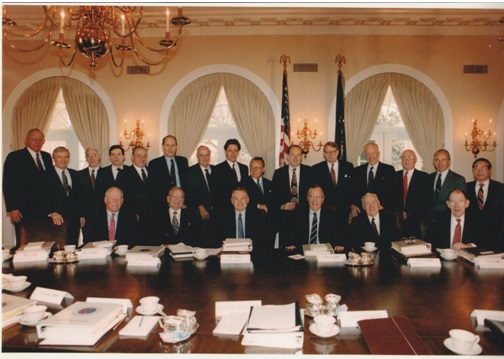 The trip briefing meeting at the White House on 1/19/1991
The trip briefing meeting at the White House on 1/19/1991
Air Force One
The Air Force One that President Bush used was a Boeing VC-25, which was a military version of the 747-200B. Not only did President George H.W. Bush use this plane, but so did other presidents, such as Bill Clinton, George W. Bush, and Barack Obama.
Chen and the 19 other executives had the opportunity to fly on the backup Air Force One (identical as the first one), while President Bush flew on Air Force One with his officers and aides. However, the business executives did spend about 20% of time with President Bush on Air Force One to discuss trade matters.
On Monday, December 30, 1991, when the Air Force One flew from Andrew’s Air Force Base near D.C. towards Asia, it was a moment of emotional reflection for Winston Chen. He had grown from a poor foreign student to a member of the Presidential Business Delegation. He was forever grateful to Harvard and America. He was the only Asian among the delegation members, which consisted of practically all Caucasians. While it was tough for minorities to succeed, America provided opportunities to everyone. What mattered in America was your capability, regardless of your skin color or family background. Without America’s spirit of equal opportunity, Chen would not have stepped onto Air Force One.
During the flight to four nations in Asia-Pacific, President Bush held several meetings on Air Force One with the executives to discuss strategies on how to increase American exports to Asian-Pacific countries, especially Japan. Many executives pointed out the rigid rules in Japan that prevented foreign companies to compete freely. For example was Toys R Us which planned to open a branch in Japan, lowering the retail price significantly for consumers. Unfortunately, the company did not receive its permit because of zoning issues and retail regulations for many years. Japan had many layers of distribution, and their trade associations had lobbying influence to prevent the entry of new businesses.
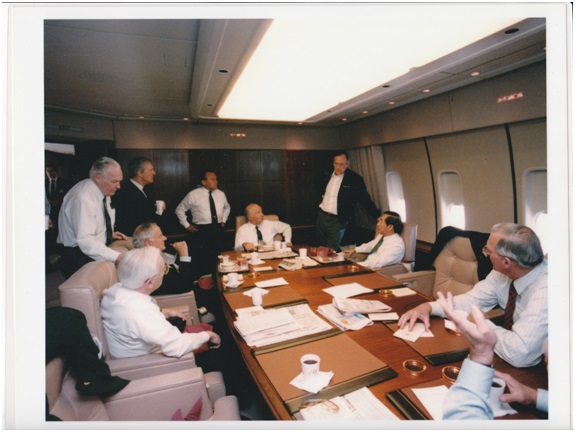 President Bush held meetings with business executives on Air Force One to discuss how to expand U.S. export to the Asian markets
President Bush held meetings with business executives on Air Force One to discuss how to expand U.S. export to the Asian markets
State Dinner, Wednesday, January 8th, 1992
Bush Collapsed
It was a busy day on Wednesday. The Business Delegation started the day with a breakfast meeting with the American Chamber of Commerce-Japan at the Okura Hotel.
A state welcome ceremony was held at the Akasaka Palace at 10:30 AM. Emperor Akihito, Empress Michiko, Prime Minister Miyazawa, and Mrs. Miyazawa greeted President Bush, Mrs. Barbara Bush and the Business Delegation at the Akasaka Palace Garden.
In Japanese, “Tenno,” or Emperor means, “Heavenly Sovereign.” The Emperor was the symbol of the State and was also the highest authority of the Shinto religion. The Emperor and his family were said to be the direct descendants of the sun-goddess Amaterasu. Before the end of the World War II, no earthly human beings were allowed to see the Emperor. After Japan surrendered, Emperor Hirohito, the father of Emperor Akihito crossed the palace moat to visit General MacArthur’s headquarters at the Dai-Ichi Life Insurance Company on September 27, 1945. This was the first time an American had ever seen the Japanese Emperor.
Emperor Akihito looked dignified in greeting the American guests. Empress Michiko was graceful and elegant. President Bush looked vigorous and high-spirited with his usual big, friendly smile. He did not show signs of exhaustion from the extraneous trip schedule. Mrs. Barbara was very popular and admired by the Japanese. She looked homely, personable, sincere, and very warm in contrast to Japanese formality.
The state dinner started at 6:30 PM at the residence of the Prime Minister. There were 135 guests including American Delegation members and Japanese officials. At 7:20 P.M., Mr. Bush entered the dining hall for a four-course dinner that consisted of cold salmon with caviar, a clear soup with mushrooms, medallions of American beef with pepper sauce, and passion fruit ice cream. President Bush was to exchange toasts with Mr. Miyazawa, a ritual at all such dinners, about an hour later.
At approximately 8:20 P.M, a strange phenomenon occurred. Silence propagated from the head table to the far side of the hall, the music stopped, conversations ceased, and people froze. Everyone was horrified by the eerie silence. In a split second, all guests turned their attention to the head table. President Bush looked pale as a white sheet, and closed his eyes as he started to wobble. Many questions flashed in people’s mind. “Did he have a heart attack?” He tilted left toward Mr. Miyazawa and vomited on the lapel of Miyazawa’s dark suit jacket. Miyazawa cradled the President’s head as he struggled to regain his composure. One Secret Service agent vaulted atop the dinner table. A second one eased Bush to the floor.
In a few minutes, the President recovered and remarked to the agents, “I just wanted to get a little attention.” With the help of the agents, he stood to leave. He looked haggard and feeble. Everyone applauded when the President stood up. He wore a green overcoat, provided by a Secret Service agent, to cover his soiled clothing as he walked to his limousine. An ambulance waiting at the front door was not used. The President was driven back to his guest suite at Akasaka Palace.
This incident happened very, very fast, stunning the 135 dinner guests and the whole world. The dinner was recorded for Japan’s semi-official television network, NHK, which broadcast live coverage. Throughout the evening, recorded footage of a prone and frail Mr. Bush, was aired again and again all over the world.
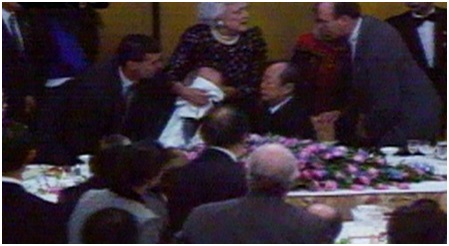 Mrs. Bush covered President Bush’s mouth. Source: NHK TV
Mrs. Bush covered President Bush’s mouth. Source: NHK TV
After President Bush left, Mrs. Barbara Bush and Mr. Miyazawa tried to stay calm and to comfort the guests. As the guests calmed down, Mrs. Bush proposed a toast, jokingly telling the crowd, “You know, I can’t explain what happened to George, because it’s never happened before. But I’m beginning to think it’s the Ambassador’s fault.” She referred to Michael H. Armacost, the United States Ambassador to Japan. “He and George played the Emperor and the Crown Prince in tennis today, and they were badly beaten. And we Bushes aren’t used to that. So he felt much worse than I thought.”
The crowd exploded with applause. Both the Japanese and Americans were overwhelmed by her wit and grace. Barbara Bush was such a hit with the Japanese audiences that her face was immediately spread all over the popular newspapers. The wives of every recent Prime Minister were interviewed, and they commented on how admiring they were of her witty and spontaneous television performance.
Thursday morning, January 9th, Marlin Fitzwater, the White House spokesman in Tokyo announced that President Bush was in his suite at the Akasaka Palace and was feeling fine following a bout with the flu. The President’s personal physician, Dr. Burton Lee, said the President was in good shape and felt okay. People were relieved to hear that President Bush had recovered and appeared not to have any major health issues.
The Business Delegation meetings with Japanese officials and business executives continued. The last automotive executive meeting was held at 5:00 p.m., and was followed by a dinner hosted by Secretary Mosbacher at Ambassador Armacost’s residence.
Epilogue
The news that President Bush collapsed in front of the Prime Minister spread like wildfire in more than one country. Due to extreme fatigue and exhaustion, Bush fell ill with Intestinal Flu. Out of three days of intense negotiations, the Japanese agreed to increase the purchase of American auto parts to $10 billion in 1995. Really, this was a drop in the bucket to help cut the American trade deficit with Japan. Japanese automakers gave the U.S. Presidential Business Delegation a high stack of documents of their purchase plans, but the results were disappointing. The trade deficit with Japan continued to grow from $43.4 billion in 1991 to $49.6 billion in 1992, $59.1 billion in 1995 and $81.6 billion in 2000.
Apparently, government intervention did not work well in the global free trade system. Customer acceptance overwhelmed political influence. During this time, the United States prestige hit an all-time low, while Japan reached its economic zenith. Under political pressure, Prime Minister Miyazawa persuaded Japanese auto executives to make some sacrifices and increase the purchase of American auto parts out of sympathy or compassion.
In the 1992 Presidential Election, George W.H. Bush was defeated by an obscure governor from Arkansas, Bill Clinton. Clinton’s successful phrase was, “It’s the economy, stupid.” Unfortunately, President Bush failed in his mission to save the United States from the burden of the trade deficit with Japan.
As for Winston Chen, he retired from his position as CEO of Solectron in late 1992, and stepped down as Chairman in 1994. After working 12-14 hours a day, six days a week for 16 years at Solectron, he wanted to pursue other interests. He remained on the board of Solectron until 2000. He set up a charitable organization, Paramitas Foundation, to provide scholarships to universities and support community services. He served on the board of directors of Intel for 11 years from 1994. He also served on the board of trustees of Stanford University and Santa Clara University for 10 and 15 years, respectively.
Recalling the generous fellowship Harvard offered him, Chen was inspired to help educate engineers and scientists for this country. His foundation has helped several hundred graduate and undergraduate students since 1994. He believed that only the best university education can help sustain American innovation in an ever-changing and uncertain world.
Even without Winston Chen, Solectron continued to grow and became the largest electronics manufacturing service company in the world. Under the new CEO Ko Nishimuro the company flourished and grew to $18 billion in sales in 2000 with many acquisitions. The number of employees reached 80,000, and the stock rose about 250 times since its IPO in 1989. Unfortunately the company was not exempt from downturn impact after the internet bubble burst in 2000.
President Bush’s 12-day trip was a good intention, but did not help end America’s recession, nor did it help Bush get re-elected in 1992. But history is full of surprises. Historians would remember that the moment when Bush vomited on Prime Minister Miyazawa’s lapel, America had already embarked on an unanticipated era of innovation and prosperity. Similarly by no means Prime Minister Miyazawa could have imagined the distressing 20+ years of decline of Japan’s economy after he met President in 1992.
Although Japan seemed to be successful and unstoppable in early 1990’s, America remains stronger than Japan through innovation and creativity after President Bush’s visit to Japan in 1992. Even leading into the 21st century, America continues to go strong with new ideas and to explore new technologies.
The unbelievable journey in American history shows us that miracles happen unexpectedly, not only in major situations like our economic crisis dealing with Japan, but also in our lives, just like in Winston Chen’s.
His miracle began with the opportunity to attend Harvard University on scholarship, and culminated on his becoming CEO of a multi-billion dollar company.
To him, his accomplishment was not due to his talents or his hard work, rather was due to the miracles. True miracles happened when Harvard’s generosity offered him a scholarship without asking anything in return. Miracles happened when the American society offered so many opportunities for him to thrive. Miracles happened when an immigrant can build a multi-billion company with a modest investment. Miracles happened when the President of the United States invited him to travel on the Air Force One regardless of his background and the color of his skin. These miracles don’t happen often in the world except in America. He prays that these miracles will continue to repeat in America for everyone again and again so that we can enjoy the prosperity and happiness in our society. Without a doubt, the twisted story of the almost defeated American economy in the late 20th Century intermingled with an immigrant story of an Asian graduate student, Winston Chen, who made an interesting impact in our society, is a story to be remembered.
源自 陳文雄

